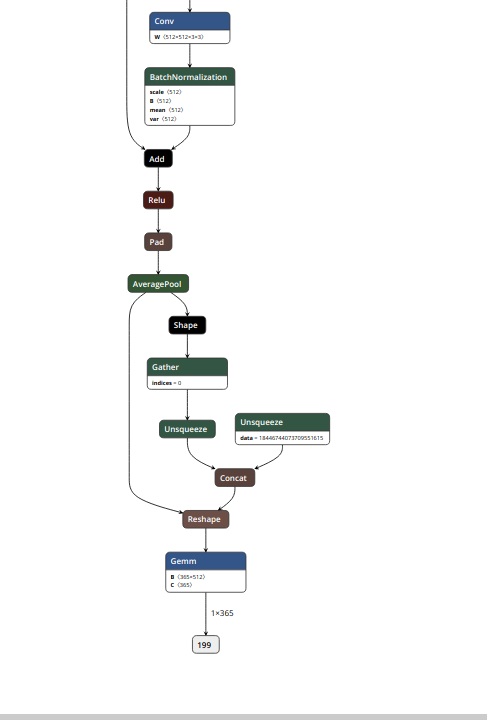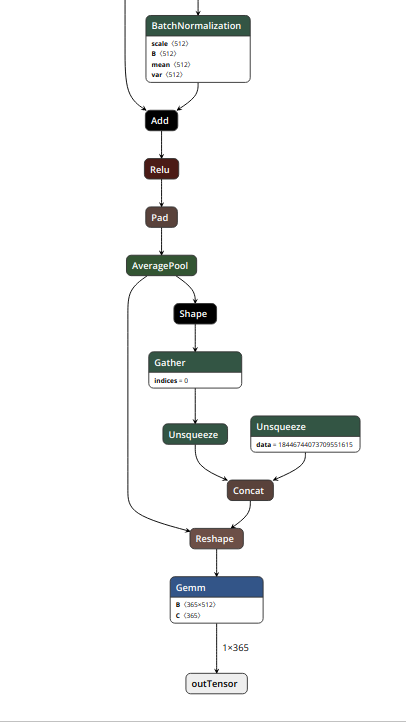pytorch模型部署在MacOS或者IOS
pytorch训练出.pth模型如何在MacOS上或者IOS部署,这是个问题。
然而我们有了onnx,同样我们也有了coreML。
ONNX:
onnx是一种针对机器学习设计的开放式文件格式,用来存储训练好的模型,并进行多种框架模型间的转换。
coreML:
Apple在2017年 MacOS 10.13以及IOS11+系统上推出了coreML1.0,官网地址:https://developer.apple.com/documentation/coreml 。
2018年又推出MacOS 10.14以及IOS12系统上的coreML2.0 https://www.appcoda.com/coreml2/。
coreML框架可以方便的进行深度学习模型的部署,利用模型进行预测,让深度学习可以在apple的移动设备上发光发热。而开发者需要做的仅仅是将model.mlModel拖进xcode工程,xcode工程会自动生成以模型名称命名的object-c类以及多种进行预测所需的类接口。
pytorch -- ONNX -- coreML
没错,就是这个流程。我们有训练好的.pth模型,通过pytorch.onnx.export() 转化为 .onnx模型,然后利用 onnx_coreml.convert()将 .onnx转换为 .mlModel。将.mlModel拖进xcode工程编写预测代码就可以了。
1. pytorch -- ONNX
请先查看pytorch官网的onnx模块:https://pytorch.org/docs/stable/onnx.html 。 主要的代码就这一个API, 各个参数意义请查阅文档。
torch.onnx.export(model, dummy_input, "alexnet.onnx", verbose=True, input_names=input_names, output_names=output_names); 转换部分代码如下:
batch_size=1
onnx_model_path = "onnx_model.onnx"
dummy_input = V(torch.randn(batch_size, 3, 224, 224), requires_grad=True)
torch_out= torch.onnx.export(pytorch_model, dummy_input , onnx_model_path, verbose=True,input_names=['image'], output_names=['outTensor'], export_params=True, training=False )
这里有一个需要注意的地方就是input_names和output_names的设置,如果不设置的情况,输入层和输出层pytorch会自动分配一个数字编号。比如下图(用netron工具查看,真是一个很好用的工具 https://pypi.org/project/netron/)。 自动分配的输入名称和输出名称是0 和 199。 这样转换成coreML模型后加载到xcode中会出现"initwith0"这样的编译错误,就是模型初始化的时候不能正确处理这个输入名称0。因此最好是在export的时候将其修改一个名称。


修改之后的模型是这样的,可以看到模型的输入和输出名称都发生的修改:


2. onnx -- mlModel
这一部分需要安装onnx, github地址: https://github.com/onnx/onnx 以及安装一个转换工具onnx_coreML,github地址:https://github.com/onnx/onnx-coreml 。里面用到了一个coremltools : https://pypi.org/project/coremltools/,这个tool目前仅支持python2.7环境下使用。
安装好后, import onnx , import onnx_coreML 就可以使用。转换代码如下:
onnx_model = onnx.load("onnx_model.onnx")
cml_model= onnx_coreml.convert(onnx_model)
cml_model.save("coreML_model.mlmodel")
当然, onnx_coreml.convert有很多参数,可以用来预处理,设置bgr顺序等,请参看github文档介绍。
现在将coreML_model.mlModel拖进xcode工程里,会自动生成一个coreML_model类,这个类有初始化模型,输入 预测 输出等API,编写预测代码即可。
3. 在最新的coreML2.0中,支持模型的量化. coreML1.0中处理模型是32位,而在coreML2.0中可以将模型量化为16bit, 8bit, 4bit甚至是2bit,并且可以设置量化的方法。 具体请看apple WWDC视频以及PPT。
模型量化仍然是使用coreMLtool2.0工具,具体代码请查阅这篇博客,写的很详细:https://www.jianshu.com/p/b6e3cb7338bf。 两句代码即可完成量化转换,代码如下:
import coremltools
from coremltools.models.neural_network.quantization_utils import * model = coremltools.models.MLModel('Model.mlmodel')
lin_quant_model = quantize_weights(model, 8, "linear")
lin_quant_model.save('Model_8bit.mlmodel')
时间仓促,写的粗糙,随后更新。
———————————今天来更新————————————————
1. 将模型拖进xcode工程后,点击模型将在右侧页面看到这样的信息,包括模型的名称、尺寸、输入、输出等信息,并且会提示已经自动生成Objective-c的模型类文件:

点击Model右侧的箭头可以跳转到model类的头文件model.h。里面包含了模型初始化以及预测等接口。如下:
//
// Model.h
//
// This file was automatically generated and should not be edited.
// #import <Foundation/Foundation.h>
#import <CoreML/CoreML.h>
#include <stdint.h> NS_ASSUME_NONNULL_BEGIN /// Model Prediction Input Type
API_AVAILABLE(macos(10.13), ios(11.0), watchos(4.0), tvos(11.0)) __attribute__((visibility("hidden")))
@interface ModelInput : NSObject<MLFeatureProvider> /// image as color (kCVPixelFormatType_32BGRA) image buffer, 224 pixels wide by 224 pixels high
@property (readwrite, nonatomic) CVPixelBufferRef image;
- (instancetype)init NS_UNAVAILABLE;
- (instancetype)initWithImage:(CVPixelBufferRef)image;
@end /// Model Prediction Output Type
API_AVAILABLE(macos(10.13), ios(11.0), watchos(4.0), tvos(11.0)) __attribute__((visibility("hidden")))
@interface ModelOutput : NSObject<MLFeatureProvider> /// MultiArray of shape (1, 1, 10, 1, 1). The first and second dimensions correspond to sequence and batch size, respectively as multidimensional array of floats
@property (readwrite, nonatomic, strong) MLMultiArray * outTensor;
- (instancetype)init NS_UNAVAILABLE;
- (instancetype)initWithOutTensor:(MLMultiArray *)outTensor;
@end /// Class for model loading and prediction
API_AVAILABLE(macos(10.13), ios(11.0), watchos(4.0), tvos(11.0)) __attribute__((visibility("hidden")))
@interface Model : NSObject
@property (readonly, nonatomic, nullable) MLModel * model;
- (nullable instancetype)init;
- (nullable instancetype)initWithContentsOfURL:(NSURL *)url error:(NSError * _Nullable * _Nullable)error;
- (nullable instancetype)initWithConfiguration:(MLModelConfiguration *)configuration error:(NSError * _Nullable * _Nullable)error API_AVAILABLE(macos(10.14), ios(12.0), watchos(5.0), tvos(12.0)) __attribute__((visibility("hidden")));
- (nullable instancetype)initWithContentsOfURL:(NSURL *)url configuration:(MLModelConfiguration *)configuration error:(NSError * _Nullable * _Nullable)error API_AVAILABLE(macos(10.14), ios(12.0), watchos(5.0), tvos(12.0)) __attribute__((visibility("hidden"))); /**
Make a prediction using the standard interface
@param input an instance of ModelInput to predict from
@param error If an error occurs, upon return contains an NSError object that describes the problem. If you are not interested in possible errors, pass in NULL.
@return the prediction as ModelOutput
*/
- (nullable ModelOutput *)predictionFromFeatures:(ModelInput *)input error:(NSError * _Nullable * _Nullable)error; /**
Make a prediction using the standard interface
@param input an instance of ModelInput to predict from
@param options prediction options
@param error If an error occurs, upon return contains an NSError object that describes the problem. If you are not interested in possible errors, pass in NULL.
@return the prediction as ModelOutput
*/
- (nullable ModelOutput *)predictionFromFeatures:(ModelInput *)input options:(MLPredictionOptions *)options error:(NSError * _Nullable * _Nullable)error; /**
Make a prediction using the convenience interface
@param image as color (kCVPixelFormatType_32BGRA) image buffer, 224 pixels wide by 224 pixels high:
@param error If an error occurs, upon return contains an NSError object that describes the problem. If you are not interested in possible errors, pass in NULL.
@return the prediction as ModelOutput
*/
- (nullable ModelOutput *)predictionFromImage:(CVPixelBufferRef)image error:(NSError * _Nullable * _Nullable)error; /**
Batch prediction
@param inputArray array of ModelInput instances to obtain predictions from
@param options prediction options
@param error If an error occurs, upon return contains an NSError object that describes the problem. If you are not interested in possible errors, pass in NULL.
@return the predictions as NSArray<ModelOutput *>
*/
- (nullable NSArray<ModelOutput *> *)predictionsFromInputs:(NSArray<ModelInput*> *)inputArray options:(MLPredictionOptions *)options error:(NSError * _Nullable * _Nullable)error API_AVAILABLE(macos(10.14), ios(12.0), watchos(5.0), tvos(12.0)) __attribute__((visibility("hidden")));
@end NS_ASSUME_NONNULL_END
其中带有这样标志的表示是coreML1.0版本的接口以及对应的系统版本:
API_AVAILABLE(macos(10.13), ios(11.0), watchos(4.0), tvos(11.0))
下面的是coreML2.0新增的接口以及对应的系统版本:
API_AVAILABLE(macos(10.14), ios(12.0), watchos(5.0), tvos(12.0))
2. 说一下几个常用API的使用:
① 首先是模型的初始化加载,初始化接口如下几个:
- (nullable instancetype)init;
- (nullable instancetype)initWithContentsOfURL:(NSURL *)url error:(NSError * _Nullable * _Nullable)error;
- (nullable instancetype)initWithConfiguration:(MLModelConfiguration *)configuration error:(NSError * _Nullable * _Nullable)error API_AVAILABLE(macos(10.14), ios(12.0), watchos(5.0), tvos(12.0)) __attribute__((visibility("hidden")));
- (nullable instancetype)initWithContentsOfURL:(NSURL *)url configuration:(MLModelConfiguration *)configuration error:(NSError * _Nullable * _Nullable)error API_AVAILABLE(macos(10.14), ios(12.0), watchos(5.0), tvos(12.0)) __attribute__((visibility("hidden")));
当然,最简单的初始化方法就是第一个:
model = [ [Model alloc] init ];
如果需要设置设备上计算单元的话,就去调用coreML2.0新增的initWithConfiguration接口,多的两个参数分别是(MLModelConfiguration *)configuration 以及 NSError *error。调用方法如下:
MLModelConfiguration *config = [ [MLModelConfiguration alloc] init];
config.computeUnits = MLComputeUnitsCpuOnly;// NSError *error;
model = [ [nimaModel alloc] initWithConfiguration:config error:&error];
其中config值有三种情况可以选择,分别是
MLComputeUnitsCPUOnly ----仅仅使用CPU计算;
MLComputeUnitsCPUAndGPU ----使用CPU和GPU计算;
MLComputeUnitsAll -----使用所有计算单元进行计算(主要指A11以及A12仿生芯片中的netrual engine) 具体见如下的MLModelConfiguration.h文件
#import <Foundation/Foundation.h>
#import <CoreML/MLExport.h> NS_ASSUME_NONNULL_BEGIN typedef NS_ENUM(NSInteger, MLComputeUnits) {
MLComputeUnitsCPUOnly = ,
MLComputeUnitsCPUAndGPU = ,
MLComputeUnitsAll = } API_AVAILABLE(macos(10.14), ios(12.0), watchos(5.0), tvos(12.0)); /*!
* An object to hold options for loading a model.
*/
API_AVAILABLE(macos(10.14), ios(12.0), watchos(5.0), tvos(12.0))
ML_EXPORT
@interface MLModelConfiguration : NSObject <NSCopying> @property (readwrite) MLComputeUnits computeUnits; @end NS_ASSUME_NONNULL_END
初始化的两个两个API用的不多,暂且按住不表。
② 模型的输入API。
/// Model Prediction Input Type
API_AVAILABLE(macos(10.13), ios(11.0), watchos(4.0), tvos(11.0)) __attribute__((visibility("hidden")))
@interface ModelInput : NSObject<MLFeatureProvider> /// image as color (kCVPixelFormatType_32BGRA) image buffer, 224 pixels wide by 224 pixels high
@property (readwrite, nonatomic) CVPixelBufferRef image;
- (instancetype)init NS_UNAVAILABLE;
- (instancetype)initWithImage:(CVPixelBufferRef)image;
@end
ModelInput类的API很简单,就用一个initWithImage就可以了,多做的一步就是需要将UIImage或者OpenCV加载的图像转换为CVPixelBuffer。然后使用API创建ModelInput:
ModelInput *input = [[ModelInput alloc] initWithImage:buffer];
③ 模型的预测API。
/**
Make a prediction using the standard interface
@param input an instance of ModelInput to predict from
@param error If an error occurs, upon return contains an NSError object that describes the problem. If you are not interested in possible errors, pass in NULL.
@return the prediction as ModelOutput
*/
- (nullable ModelOutput *)predictionFromFeatures:(ModelInput *)input error:(NSError * _Nullable * _Nullable)error; /**
Make a prediction using the standard interface
@param input an instance of ModelInput to predict from
@param options prediction options
@param error If an error occurs, upon return contains an NSError object that describes the problem. If you are not interested in possible errors, pass in NULL.
@return the prediction as ModelOutput
*/
- (nullable ModelOutput *)predictionFromFeatures:(ModelInput *)input options:(MLPredictionOptions *)options error:(NSError * _Nullable * _Nullable)error; /**
Make a prediction using the convenience interface
@param image as color (kCVPixelFormatType_32BGRA) image buffer, 224 pixels wide by 224 pixels high:
@param error If an error occurs, upon return contains an NSError object that describes the problem. If you are not interested in possible errors, pass in NULL.
@return the prediction as ModelOutput
*/
- (nullable ModelOutput *)predictionFromImage:(CVPixelBufferRef)image error:(NSError * _Nullable * _Nullable)error; /**
Batch prediction
@param inputArray array of ModelInput instances to obtain predictions from
@param options prediction options
@param error If an error occurs, upon return contains an NSError object that describes the problem. If you are not interested in possible errors, pass in NULL.
@return the predictions as NSArray<ModelOutput *>
*/
- (nullable NSArray<ModelOutput *> *)predictionsFromInputs:(NSArray<ModelInput*> *)inputArray options:(MLPredictionOptions *)options error:(NSError * _Nullable * _Nullable)error API_AVAILABLE(macos(10.14), ios(12.0), watchos(5.0), tvos(12.0)) __attribute__((visibility("hidden")));
@end
前面两个是标准的API。他俩的差异在于 Options: (MLPredictionOptions *)options 这个参数。第2个API中可以设置Options参数,这个是coreML1.0中就有的,具体见如下的MLPredictionOptions.h文件。
//
// MLPredictionOptions.h
// CoreML
//
// Copyright © 2017 Apple Inc. All rights reserved.
//
#import <Foundation/Foundation.h>
#import <CoreML/MLExport.h> NS_ASSUME_NONNULL_BEGIN /*!
* MLPredictionOptions
*
* An object to hold options / controls / parameters of how
* model prediction is performed
*/
API_AVAILABLE(macos(10.13), ios(11.0), watchos(4.0), tvos(11.0))
ML_EXPORT
@interface MLPredictionOptions : NSObject // Set to YES to force computation to be on the CPU only
@property (readwrite, nonatomic) BOOL usesCPUOnly; @end NS_ASSUME_NONNULL_END
Option值默认不设置则为No,也就是说默认使用GPU,如果想要只使用CPU,调用时将其值设置为Yes即可。
MLPredictionOptions *option = [ [MLPredictionOptions alloc] init];
option.usesCPUOnly = yes;
第三个API没有Options选项,但是可以直接将CVPixelBuffer作为输入,不用创建ModelInput。是一种更为简便的API接口。
而第四个API是coreML2.0新增的batchPrediction接口。前面三个API一次只能输入一幅图像预测。而这个接口可以将多个输入组织为NSArray,作为一个Batch一次性传入。并得到NSArray形式的输出。更加快速,不用再去写for循环。
以第三个形式的预测API为例,调用代码如下:
ModelOutput *output = [model predictionFromFeatures:input options:option error:&error];
④ 模型输出API:
/// Model Prediction Output Type
API_AVAILABLE(macos(10.13), ios(11.0), watchos(4.0), tvos(11.0)) __attribute__((visibility("hidden")))
@interface ModelOutput : NSObject<MLFeatureProvider> /// MultiArray of shape (1, 1, 10, 1, 1). The first and second dimensions correspond to sequence and batch size, respectively as multidimensional array of floats
@property (readwrite, nonatomic, strong) MLMultiArray * outTensor;
- (instancetype)init NS_UNAVAILABLE;
- (instancetype)initWithOutTensor:(MLMultiArray *)outTensor;
@end
modelOutput默认是MLMultiArray类型,当模型有多个输出的时候,根据输出output.outTensor, outTensor.feature .... 等等 依次获取。示例模型只有一个输出,因此只有一个outTensor。
夜已深,就此打住。
pytorch模型部署在MacOS或者IOS的更多相关文章
- 使用C++调用并部署pytorch模型
1.背景(Background) 上图显示了目前深度学习模型在生产环境中的方法,本文仅探讨如何部署pytorch模型! 至于为什么要用C++调用pytorch模型,其目的在于:使用C++及多线程可以加 ...
- PyTorch专栏(六): 混合前端的seq2seq模型部署
欢迎关注磐创博客资源汇总站: http://docs.panchuang.net/ 欢迎关注PyTorch官方中文教程站: http://pytorch.panchuang.net/ 专栏目录: 第一 ...
- 使用C++调用pytorch模型(Linux)
前言 模型转换思路通常为: Pytorch -> ONNX -> TensorRT Pytorch -> ONNX -> TVM Pytorch -> 转换工具 -> ...
- Intel发布神经网络压缩库Distiller:快速利用前沿算法压缩PyTorch模型——AttributeError: module ‘tensorboard' has no attribute 'lazy'
转载自:CSDN Nine-days 近日,Intel 开源了一个用于神经网络压缩的开源 Python 软件包 Distiller,它可以减少深度神经网络的内存占用.加快推断速度及节省能耗.Dis ...
- 如何使用flask将模型部署为服务
在某些场景下,我们需要将机器学习或者深度学习模型部署为服务给其它地方调用,本文接下来就讲解使用python的flask部署服务的基本过程. 1. 加载保存好的模型 为了方便起见,这里我们就使用简单的分 ...
- 混合前端seq2seq模型部署
混合前端seq2seq模型部署 本文介绍,如何将seq2seq模型转换为PyTorch可用的前端混合Torch脚本.要转换的模型来自于聊天机器人教程Chatbot tutorial. 1.混合前端 在 ...
- 资源分享 | PyTea:不用运行代码,静态分析pytorch模型的错误
前言 本文介绍一个Pytorch模型的静态分析器 PyTea,它不需要运行代码,即可在几秒钟之内扫描分析出模型中的张量形状错误.文末附使用方法. 本文转载自机器之心 编辑:CV技 ...
- Pytorch模型量化
在深度学习中,量化指的是使用更少的bit来存储原本以浮点数存储的tensor,以及使用更少的bit来完成原本以浮点数完成的计算.这么做的好处主要有如下几点: 更少的模型体积,接近4倍的减少: 可以更快 ...
- 在MacOS和iOS系统中使用OpenCV
在MacOS和iOS系统中使用OpenCV 前言 OpenCV 是一个开源的跨平台计算机视觉库,实现了图像处理和计算机视觉方面的很多通用算法. 最近试着在 MacOS 和 iOS 上使用 OpenCV ...
随机推荐
- String工具类
String工具类 问题描述 MAVEN依赖 代码成果 问题描述 很多时候我们需要对字符串进行很多固定的操作,而这些操作在JDK/JRE中又没有预置,于是我们想到了apache-commons组件,但 ...
- Redis Sentinel 配置文件
基础参考:https://www.cnblogs.com/wang-li/p/9955303.html 配置文件讲解 1.sentinel monitor # sentinel monitor < ...
- CodeSampler DX9 Full-screen initialization
D3D新手,请轻拍. 最近在学CodeSampler上的DX9范例.编译环境是VS2012.搭编译环境用了一两天,另行开文吐槽(有时间的话). 本文讲讲Full-screen initializati ...
- [小结] 中山纪念中学2018暑期训练小结(划掉)(颓废记)-Day10
[小结] 中山纪念中学2018暑期训练小结(划掉)(颓废记)-Day10 各位看众朋友们,你们好,今天是2018年08月14日,星期二,农历七月初四,欢迎阅看今天的颓废联编节目 最近发生的灵异事件有 ...
- ppt演讲者模式
步骤如下: 1 win+p 2 选择扩展 3 选幻灯片放映 4 设置幻灯片放映 5 显示器二 6 勾选显示演示者视图
- Vim常用的命令
Noted:均在命令模式下进行的 移动: j---->向下 k---->向上 l---->向右 h---->向左 保存: w---->保存 退出: q---->退出 ...
- Spring——事务
Spring事务 事务的ACID特性 原子性(Atomicity):在事务中的操作,要么都执行,要么都不执行! 一致性(Consistency):数据从一种状态,同时到达另一种状态. 持久性(Dura ...
- 获取列表菜单的选项值与选项以后的VALUE
<html> <body> <select id="izan" name="" onchange='izzzz()'> &l ...
- 团队-Forward团队-团队一阶段互评
团队名称:Forward团队 学号:2015035107105 得分:7 原因:知识欠缺,能够一边学一边做 学号:2015035107109 得分:6 原因:对我有很多帮助 学号:2015035107 ...
- 虚拟机安装+配置federa
安装 安装好后发现鼠标卡卡的,在虚拟机的显示设置里面启用3D加速: 配置 查看 显卡信息:lspci |grep VGA 测试显卡驱动:glxgears 安装必要软件 安装右键打开终端:sudo yu ...
